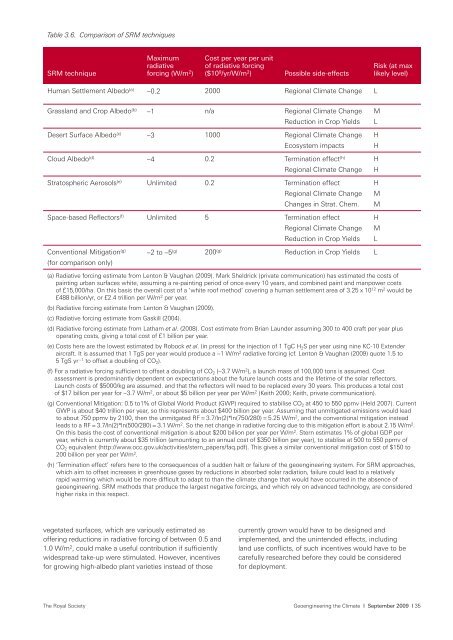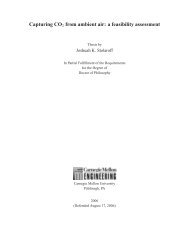Royal Society - David Keith
Royal Society - David Keith
Royal Society - David Keith
You also want an ePaper? Increase the reach of your titles
YUMPU automatically turns print PDFs into web optimized ePapers that Google loves.
Table 3.6. Comparison of SRM techniques<br />
SRM technique<br />
Maximum<br />
radiative<br />
forcing (W/m 2 )<br />
Cost per year per unit<br />
of radiative forcing<br />
($10 9 /yr/W/m 2 ) Possible side-effects<br />
Risk (at max<br />
likely level)<br />
Human Settlement Albedo (a) -0.2 2000 Regional Climate Change L<br />
Grassland and Crop Albedo (b) -1 n/a Regional Climate Change<br />
Reduction in Crop Yields<br />
Desert Surface Albedo (c) -3 1000 Regional Climate Change<br />
Ecosystem impacts<br />
Cloud Albedo (d) -4 0.2 Termination effect (h)<br />
Regional Climate Change<br />
Stratospheric Aerosols (e) Unlimited 0.2 Termination effect<br />
Regional Climate Change<br />
Changes in Strat. Chem.<br />
Space-based Reflectors (f) Unlimited 5 Termination effect<br />
Regional Climate Change<br />
Reduction in Crop Yields<br />
M<br />
L<br />
H<br />
H<br />
H<br />
H<br />
H<br />
M<br />
M<br />
H<br />
M<br />
L<br />
Conventional Mitigation (g)<br />
(for comparison only)<br />
-2 to -5 (g) 200 (g) Reduction in Crop Yields L<br />
(a) Radiative forcing estimate from Lenton & Vaughan (2009). Mark Sheldrick (private communication) has estimated the costs of<br />
painting urban surfaces white, assuming a re-painting period of once every 10 years, and combined paint and manpower costs<br />
of £15,000/ha. On this basis the overall cost of a ‘white roof method’ covering a human settlement area of 3.25 x 10 12 m 2 would be<br />
£488 billion/yr, or £2.4 trillion per W/m 2 per year.<br />
(b) Radiative forcing estimate from Lenton & Vaughan (2009).<br />
(c) Radiative forcing estimate from Gaskill (2004).<br />
(d) Radiative forcing estimate from Latham et al. (2008). Cost estimate from Brian Launder assuming 300 to 400 craft per year plus<br />
operating costs, giving a total cost of £1 billion per year.<br />
(e) Costs here are the lowest estimated by Robock et al. (in press) for the injection of 1 TgC H 2 S per year using nine KC-10 Extender<br />
aircraft. It is assumed that 1 TgS per year would produce a -1 W/m 2 radiative forcing (cf. Lenton & Vaughan (2009) quote 1.5 to<br />
5 TgS yr -1 to offset a doubling of CO 2 ).<br />
(f) For a radiative forcing sufficient to offset a doubling of CO 2 (-3.7 W/m 2 ), a launch mass of 100,000 tons is assumed. Cost<br />
assessment is predominantly dependent on expectations about the future launch costs and the lifetime of the solar reflectors.<br />
Launch costs of $5000/kg are assumed. and that the reflectors will need to be replaced every 30 years. This produces a total cost<br />
of $17 billion per year for -3.7 W/m 2 , or about $5 billion per year per W/m 2 (<strong>Keith</strong> 2000; <strong>Keith</strong>, private communication).<br />
(g) Conventional Mitigation: 0.5 to1% of Global World Product (GWP) required to stabilise CO 2 at 450 to 550 ppmv (Held 2007). Current<br />
GWP is about $40 trillion per year, so this represents about $400 billion per year. Assuming that unmitigated emissions would lead<br />
to about 750 ppmv by 2100, then the unmitgated RF = 3.7/ln(2)*ln(750/280) = 5.25 W/m 2 , and the conventional mitigation instead<br />
leads to a RF = 3.7/ln(2)*ln(500/280) = 3.1 W/m 2 . So the net change in radiative forcing due to this mitigation effort is about 2.15 W/m 2 .<br />
On this basis the cost of conventional mitigation is about $200 billion per year per W/m 2 . Stern estimates 1% of global GDP per<br />
year, which is currently about $35 trillion (amounting to an annual cost of $350 billion per year), to stablise at 500 to 550 ppmv of<br />
CO 2 equivalent (http://www.occ.gov.uk/activities/stern_papers/faq.pdf). This gives a similar conventional mitigation cost of $150 to<br />
200 billion per year per W/m 2 .<br />
(h) ‘Termination effect’ refers here to the consequences of a sudden halt or failure of the geoengineering system. For SRM approaches,<br />
which aim to offset increases in greenhouse gases by reductions in absorbed solar radiation, failure could lead to a relatively<br />
rapid warming which would be more difficult to adapt to than the climate change that would have occurred in the absence of<br />
geoengineering. SRM methods that produce the largest negative forcings, and which rely on advanced technology, are considered<br />
higher risks in this respect.<br />
vegetated surfaces, which are variously estimated as<br />
offering reductions in radiative forcing of between 0.5 and<br />
1.0 W/m 2 , could make a useful contribution if sufficiently<br />
widespread take-up were stimulated. However, incentives<br />
for growing high-albedo plant varieties instead of those<br />
currently grown would have to be designed and<br />
implemented, and the unintended effects, including<br />
land use conflicts, of such incentives would have to be<br />
carefully researched before they could be considered<br />
for deployment.<br />
The <strong>Royal</strong> <strong>Society</strong><br />
Geoengineering the Climate I September 2009 I 35








